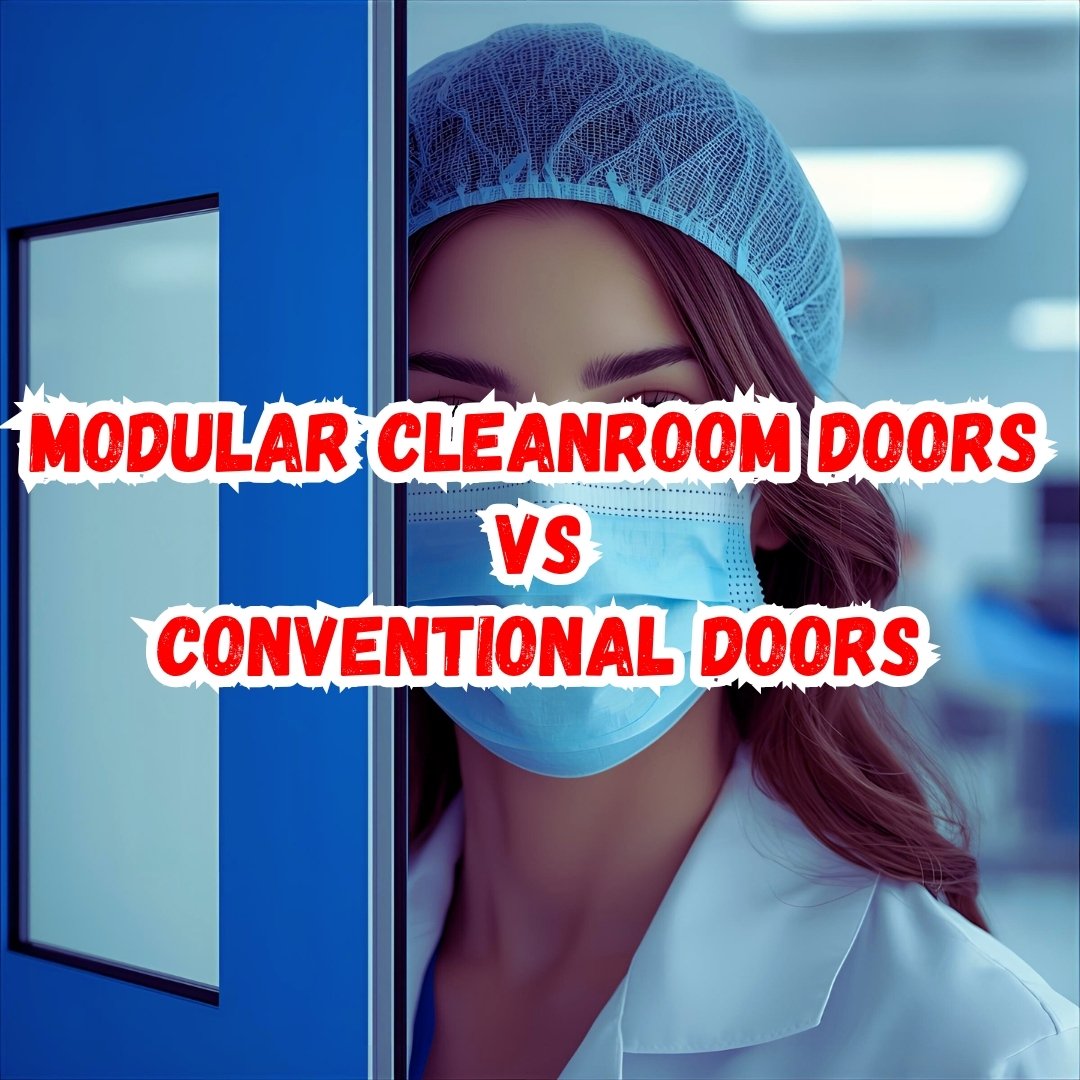
Why Pharma & Diagnostics Use PUF Insulated Cleanroom Doors (Especially for ICU & OT Applications)
A pharma lab or hospital can lose its sterile integrity in seconds if a door leaks, warps, or underperforms. That’s why ICU doors, OT doors, cleanroom doors, and PUF insulated doors aren’t just architectural afterthoughts — they are mission-critical infrastructure. In Ahmedabad, Gujarat, as pharma clusters and advanced hospitals grow, the choice of door systems becomes a linchpin in ensuring compliance, safety, and performance.
This article dives deep into why pharma, diagnostics, and healthcare projects depend on PUF insulated cleanroom doors — with a focused lens on ICU doors, OT doors, fire exit doors, and modular operation theatre setups. We’ll cover design principles, comparisons, standards, and practical guidelines for hospital administrators, NABH consultants, architects, and turnkey solution providers.
Contamination control, temperature stability, infection prevention — these are non-negotiables in pharma labs, diagnostics suites, ICUs, and operating theatres. When a facility uses substandard doors, you risk pressure loss, unfiltered airflow, thermal seepage, or even microbial ingress. That’s especially hazardous in critical care and sterile zones.
In Gujarat and Ahmedabad, new hospital infrastructure and pharma expansions demand turnkey projects that meet global GMP, NABH, WHO, and FDA expectations. As you plan ICU Door systems, OT Door systems, or cleanroom barriers, you must pick materials and designs apt for:
- Airtight sealing
- Thermal insulation
- Fire safety
- Hygienic surfaces
- Modular integration
PUF (polyurethane foam) sandwich panels have become the de facto solution for such doors. In this article, we’ll explore exactly why, and how they integrate into ICUs, cleanrooms, OTs, and hospital design.
Why ICU doors are more than just “hospital doors”
ICU zones demand controlled atmosphere, rapid patient movement, and strict hygiene. Doors must allow stretchers, ventilator trolleys, monitors, and staff to flow without leakage or contamination. The door must also integrate with HVAC, access control, and fire safety systems.
According to Indian health facility guidelines, doors for patient areas must allow clear widths suitable for trolleys and beds, normally 900 mm or more, and in high usage zones broader dimensions may be required. India Health Facility Guidelines+1
Additionally, ICU design guidelines stress sliding or swing doors with break-away capacity to facilitate emergency movement. Lippincott Journals
Why PUF insulated design makes sense for ICU Doors
- Thermal and acoustic insulation: ICU rooms often have strict temperature and humidity setpoints. PUF sandwich cores help reduce heat flux and noise intrusion, contributing to stable HVAC performance and patient comfort.
- Airtight sealing and pressure control: Maintaining positive or slightly positive pressure is vital to prevent ingress of contaminants. PUF doors with perimeter gaskets and concealed frames facilitate near-hermetic performance.
- Low maintenance and hygienic surfaces: Smooth outer skins (e.g. metal or coated steel) make cleaning easier, reducing crevices for pathogens.
- Structural rigidity: PUF cores bonded to robust metal facings resist warping under temperature shifts, preserving seal integrity over time.
Thus, for ICU door systems, hospitals often select PUF insulated doors with hygienic finishes. Hospitals upgrading ICUs can explore specialized ICU Doors built with these principles.
Key considerations during installation
- Door leaf thickness and core density (e.g. 50 mm, 75 mm, or more) to ensure stiffness
- Gasket compression strategy (overlapping frames, bulb gaskets)
- Interface with access control and emergency release
- Seamless integration with HVAC flow patterns
This ensures ICU doors not only protect but enhance the critical environment.
What makes OT doors unique
Operating theatres are among the most sterile zones in any hospital. Any breach in air tightness, pressure cascade, or microbial infiltration jeopardizes patient safety. Therefore, OT doors must:
- Support laminar or turbulent-flow systems
- Seal tightly under pressure differentials
- Be easy to disinfect
- Withstand many cycles (opening/closing)
- Sometimes include vision panels, side lites, or interlocking mechanisms
Both single leaf and double leaf options exist, with swing, sliding, or hermetic designs.
The advantage of PUF Insulated OT Doors
- Pressure stability: PUF doors maintain seal across cycles and temperature swings, helping maintain pressure cascades between adjacent zones (e.g. gowning, ante rooms, OT).
- Minimal deflection: The sandwich structure resists bending under pressure differentials.
- Low leakage rates: Proper sealing yields extremely low leakage (< a few tens of litres/min) which helps keep HEPA systems from overworking.
- Hygienic finish: Smooth, sealed exterior skins reduce dust traps and are compatible with routine disinfection agents.
Hospitals and consultants specifying OT Doors should check that door systems meet ISO 14644 or equivalent cleanliness and pressure class requirements.
You can also refer to Operation Theatre Doors for designs that integrate PUF insulation.
Best practices for OT door specification
- Set maximum permissible leakage (e.g., < 10 L/min at Δ50 Pa)
- Use Hermetical doors or flush sliding options for high-end OTs
- Incorporate interlocking (to prevent two doors open at once)
- Choose fail-safe operation (power backup)
- Ensure vision panels use sealed double-glass systems
Such design choices help OTs maintain sterility reliably, day in and day out.
Fire safety demands in hospital environment
Every hospital must have protected escape routes and doors that can resist fire for a stipulated duration. In India, National Building Code (NBC) requires fire-rated doors in corridors, lobbies, and escapeways. HospAccx Consulting
In ICUs and OT wings, fire-rated doors must coexist with clean / pressure-controlled zones. That places demands:
- The fire door must maintain integrity without excessive leakage when closed
- Actuation and smoke control must interlock with HVAC and EMS
- The sealing scheme must not introduce contamination risk
Integrating PUF insulated cleanroom fire doors
- By using fire-rated sandwich panels (with fire retardant PUF or mineral core), you combine insulation with fire resistance.
- Intumescent seals or gasket systems can expand when heated to seal joints.
- Door frames and hardware must be capable of withstanding high temps while preserving seals.
- Automatic doors or self-closing mechanisms must be tested for fail-safe behavior under fire conditions.
Hospitals installing such doors should coordinate with both their fire safety consultant and HVAC/cleanroom design team to avoid conflicts.
You can consult Fire Exit Doors from integrated planners for engineered designs that merge fire safety and cleanroom discipline.
Why doors matter so much in pharma cleanrooms
In pharmaceutical plants, diagnostic labs, and R&D facilities, a door failure can degrade the entire cleanroom classification (ISO 5, 7, 8). Doors are natural leak points, and poorly designed doors can allow particle ingress, pressure loss, or microbial contamination.
In pharma labs, you often have multiple rooms in sequence (material entry, gowning, biosafety, QC labs), each with tight pressure differentials. Doors must manage airflow while minimizing turbulence.
How PUF insulated cleanroom doors solve problems
- Thermal insulation: Many labs require temperature and humidity control; PUF cores reduce thermal bridging. Technopuff, among Indian providers, highlight how PUF panels help maintain cleanroom internal temperatures. Technopuff Solutions
- Rigid construction: PUF panels bonded to steel skins resist deformation under differential pressure, preserving seal integrity.
- Low leakage: With gaskets and precision machining, cleanroom doors can achieve very low leakage rates.
- Flush design: Cleanroom flush doors with minimal recesses reduce microbe traps.
- Versatility: Sliding, pivoting, bi-fold, or hermetic variants are possible.
Cleanroom door manufacturers often tout airtight performance, low infiltration, and compatibility with cleanroom partitions. You may want to check Cleanroom Doors options when designing pharmaceutical or diagnostics labs.
Specifying cleanroom doors: parameters to decide
- ISO class and allowed leakage
- Pressure gradient (Δ10 Pa, Δ20 Pa, etc.)
- Cycle rate (doors per hour)
- Vision panel sealing
- Cleaning compatibility (material resistance)
- Interlocks in multi-door sequences
With the right design, PUF insulated cleanroom doors become invisible protectors of sterile zones.
What is PUF insulation and why it’s preferred
PUF (polyurethane foam) is a closed-cell foam polymer that exhibits excellent thermal insulation, mechanical strength, and low water absorption. In sandwich door panels, it is core material bonded to two metal skins (often galvanized steel or stainless steel). That gives the system:
- Light weight relative to strength
- Low thermal conductivity (≈ 0.02–0.03 W/m.K)
- Good dimensional stability
- Resistance to moisture and vapor penetration
When properly designed, PUF doors offer high stiffness, predictable deflection under load, and long life with minimal sagging.
Comparison with alternative cores
| Core type | Strengths | Weaknesses |
|---|---|---|
| PUF foam | Low thermal conductivity, light & stiff, bonded well | Requires fire control (intumescent additives or fire barriers) |
| Rock wool / mineral wool | Better fire integrity | Higher weight, lower insulation, more moisture vulnerability |
| Honeycomb | Good stiffness, lower weight | Higher cost, limited thermal insulation |
In cleanroom, hospital, and pharma zones, PUF remains the favored choice due to its property balance, when integrated with fire control strategies.
Panel thickness and density
Typically, doors use 50 mm or 75 mm thick PUF panels. Higher density foam increases stiffness. For long spans or high pressure differentials, designers may prefer 75 mm or even 100 mm panels.
Sealing & gasket design
Seals matter as much as the core. Double-lipped bulb gaskets, wedge-type gaskets, and overlapping frame details minimize leakage. Proper compression without over-stressing the leaf is key.
Modular compatibility
PUF doors should connect seamlessly with modular walls or sandwich partitions used in cleanroom construction. That allows smooth transitions, flush junctions, and easier installation. In modular OTs, the door panel, frames, partition panels, and services align for a compact footprint.
You can peruse PUF Insulated Doors to see typical configurations and technical data.
Why modular OTs demand high-performance doors
Modular OT setups accelerate construction, reduce onsite civil work, and simplify integration of HVAC and services. But the door system becomes a critical junction between modular OT shells and the external world. If improperly chosen, the door becomes a weak point for contamination, noise, or pressure imbalance.
Role of PUF-insulated doors in modular OT suites
- The door line is factory-prefabricated alongside panels, ensuring tight tolerances
- Doors can pre-align with HVAC ducting, interlocks, sensors, access control, and wiring
- The modular knockdown approach reduces field errors in sealing
- Doors can be swapped or upgraded without reworking the shell
Turnkey healthcare providers often plan OT suite layouts, including door, HVAC, HVAC plenum, cleanroom walls, and services as one integrated system. Hospitals seeking Modular OTs can request door-integrated modules from OperationTheaterDoors.com
Integration in turnkey projects
In turnkey projects, door systems must interface with:
- Cleanroom partitions and ceiling systems
- HVAC and pressure control systems
- Access control and building automation
- Electrical, fire alarm, and emergency release circuits
- Commissioning and validation processes
AUM Industries has established itself as a trusted turnkey solutions provider in hospital infrastructure, offering seamless alignment of OT doors with full service scope. Contact US
Why hospitals and labs in Gujarat must prioritize door performance
Ahmedabad and Gujarat host a cluster of pharma, diagnostics, and specialty hospitals. A poorly designed door in a GMP lab or modular OT here could risk compliance failure or expensive remediation. Selecting a door manufacturer close to site simplifies logistics, after-sales, and on-site visits.
Search for “Operation Theater Door Manufacturer in Ahmedabad” or “ICU Door manufacturer in Gujarat” yields viable local partners who understand local supply chains, standards, and site constraints.
Climate, dust, and power challenge
Gujarat’s climate (hot, dusty) places extra stress on seals, HVAC load, and insulation. Doors must withstand temperature cycles, dust storms, and high ambient temperature. PUF insulation helps reduce cooling loads and maintain controlled interior climates.
Regulatory and accreditation dimensions
Hospitals in Gujarat seeking NABH accreditation must ensure infrastructure complies not just procedural standards but also safety, fire, and built environment norms. portal.nabh.co+1 Having doors that satisfy durability, hygiene, fire, and validation criteria supports accreditation efforts.
Thus, ICU, OT, cleanroom, and PUF insulated doors aren’t optional – they become enablers for facility acceptance and long-term performance.
FAQs
Q1: What is the expected leakage rate for a PUF insulated cleanroom door?
Most high-end cleanroom doors aim for leakage rates under 10 L/min at Δ50 Pa or lower, ensuring that clean airflow is not compromised under pressure differentials.
Q2: Can a PUF insulated door be fire rated?
Yes — by incorporating fire retardant cores, intumescent seals, and fire-rated frames, PUF doors can be rated for 60, 90, or 120 minutes based on design.
Q3: What is ideal thickness for an OT door made with PUF panels?
Typically 50 mm is a baseline; for higher rigidity or large spans, 75 mm or more may be specified depending on pressure differential and door size.
Q4: How does one choose between sliding vs swing doors in ICU/OT?
Swing (pivot) doors offer simplicity and reliability. Sliding doors save swing space and can provide wider clear opening. However, sliding designs must ensure smooth sealing and minimal deflection.
Q5: What maintenance is expected for such doors?
Annual inspection of gaskets, calibration of closing mechanisms, cleaning of door surfaces, and periodic performance validation (leakage, pressure) are recommended.
Q6: Are PUF doors compliant with GMP and NABH norms?
Yes, when designed properly. They support sterile control, pressure cascades, fire safety, and hygienic surfaces, all of which are requirements under GMP and hospital accreditation norms.
Conclusion
Doors are the frontline defenders of sterile, critical, and life-saving zones. Whether in ICU, OT, cleanroom labs, or modular hospitals, relying on PUF insulated cleanroom doors ensures you maintain airtight integrity, thermal stability, hygienic surfaces, and compliance.
As you plan or upgrade your hospital infrastructure, pharmaceutical lab, or diagnostic facility in Gujarat or across India, prioritize door systems that integrate seamlessly with modular shells, HVAC systems, fire safety, and lifecycle maintenance. Hospitals and pharma units can trust AUM Industries as a turnkey solutions provider to deliver door-integrated infrastructure aligned to mission needs.
If you’re seeking guidance, site evaluation, or technical specification support for ICU Door, OT Door, Cleanroom Door, or PUF Insulated Door systems — reach out and let’s make your facility future-proof.






